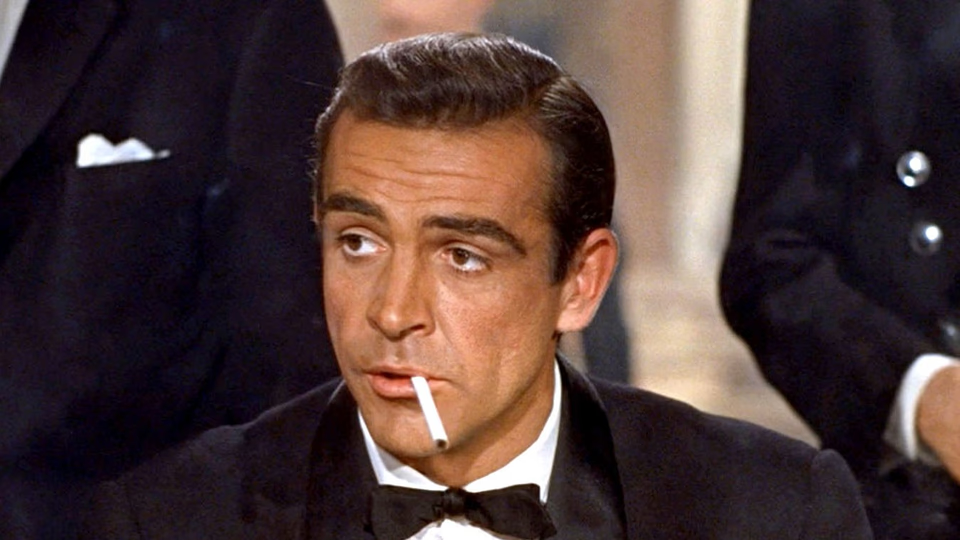Dr. No

This first entry in the James Bond franchise proves a gripping mix of hard-boiled detective story and escapist adventure.
The plot sees London dispatch Bond to Jamaica to investigate the local station chief’s murder. The trail leads him to the titular doctor, a mysterious criminal mastermind plotting to sabotage an American moon rocket.
The first two acts shine, with Bond hewing closer to a film noir protagonist than super-spy. From his now-iconic introduction at a Chemin de fer table at a private casino, the script shows us everything we need to know. His winning at Chemin de fer, a game of pure chance, shows us he’s lucky. In short order, the film also shows us he’s mildly insubordinate, a womanizer, an experienced agent, and fond of violence. All this before he’s even arrived at his Jamaican hotel.
Said arrival also sports another hard-boiled trope: the cynical one-liner. As Bond pulls up with a dead would-be assassin in the passenger seat, he deadpans to the guard on duty, “Sergeant, make sure he doesn’t get away.”
These acts make terrific use of the Jamaican locales. When Bond pokes around the docks, the mountains loom across the bay, foreshadowing a later car chase set on the twisty, dirt mountain roads.
It’s not until the film’s final third that it pivots into escapist adventure, and the Bond character with it. The gritty realism vanishes, with Bond thinking it wise to rush a flame-throwing tank with pistols. This leads to Bond and his party getting captured and imprisoned in a luxury suite. Here again, Bond displays none of his prior sense. Where he earlier opted for a fresh bottle of vodka in his hotel room, fearing his open bottle may have been tampered with, he happily drinks down the drugged coffee provided by his captors. Even the location photography suffers, with some obvious soundstage work featuring Bond aboard a sailboat followed by clear day-for-night shots.
Despite her second billing, Ursula Andress doesn’t have much to do aside from look beautiful. Her iconic bikini-clad emergence foreshadows the film’s imminent shift to near-total escapism. She’s a male fantasy personified, with no motivation and no agency, just a near-instant attraction to Connery. Connery’s take-it-or-leave-it approach to her wiles reinforces his character’s womanizing attitude.
Soon we meet the titular doctor, played by Joseph Wiseman. The years of parodies have diminished its impact, but his icy, detached delivery defined the “Bond villain” for decades to come. The same goes for production designer Ken Adam’s now iconic ‘underground headquarters’ sets.
Despite the final third not aging well, Dr. No holds up thanks to Connery’s magnetic performance.
Consider the aforementioned introduction scene. Director Terence Young cuts it together so well, it feels like an established trope. We see the Chemin de fer table, crowded with onlookers. An attractive woman wagers, then requests a card. We don’t see the dealer, whom she’s betting against, just his arm as he extends a card. She then flips over a losing hand. The table responds with astonishment. This repeats with more murmurs of astonishment. Felted, the woman rebuys for another thousand.
The camera stays on the woman but we hear Connery’s voice, “I admire your courage, Miss, uh…?”
“Trench,” she replies, “Sylvia Trench. I admire your luck, Mister…”
Cut to Connery, tuxedo clad, cigarette dangling from his lip, a dispassionate look bordering on insolence on his face.
“Bond,” says Connery, “James Bond,” as the John Barry guitar and horn theme swells in the background. A perfect marriage of film noir and 1960s surf rock. Connery embodies this amalgam, a broad-shouldered beach body with a firm jaw beneath a dark brow and eyes. He could be a younger version of Roger Duchesne’s character in Bob le Flambeur.
This incarnation stands miles apart from the later Connery and Moore versions. Here, he’s a borderline sociopathic killer, evidenced by a terrific scene where he’s interrogating a would-be assassin. The assassin makes a play for his gun, only to find it empty. In an emotionless tone, Connery remarks, “It’s a Smith and Wesson… and you’ve had your six,” then shoots the defenseless man dead.
Indeed, Dr. No comprises two separate approaches, and, unfortunately, as the franchise evolved, the gritty realism fell away, overtaken by the escapist adventure. Later films would feature elaborate gadgets, trick cars, and comedy relief in the form of Desmond Llewelyn’s Q. Bond’s character would soften too—becoming a near-parody under Roger Moore. But this first entry stands out as a “what might have been” showcasing Connery in his youthful prime, portraying an edgy, flawed character that remains the best interpretation to date.